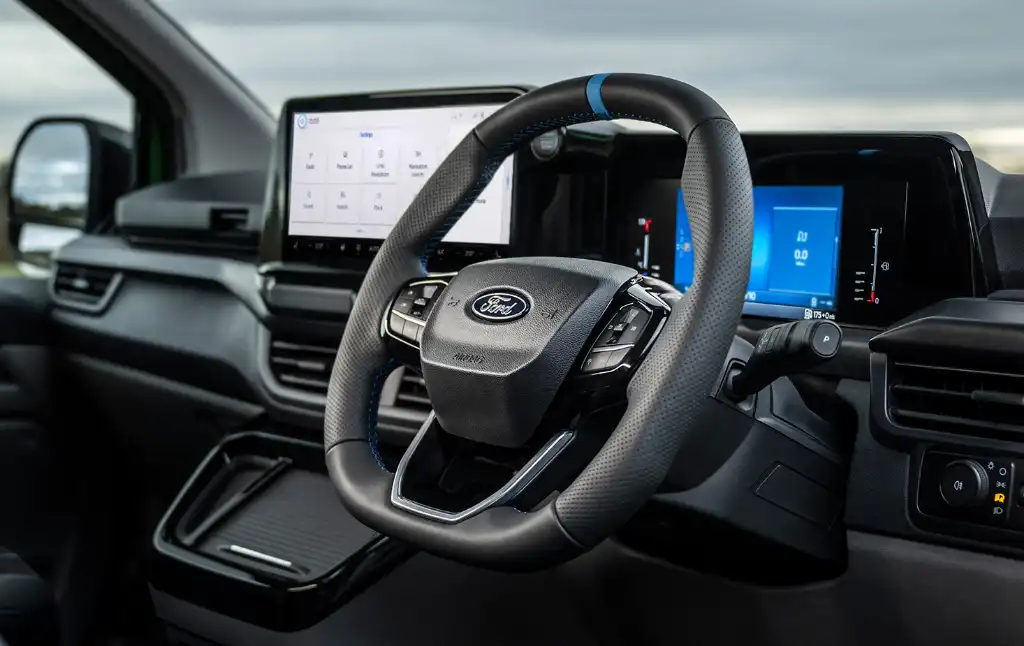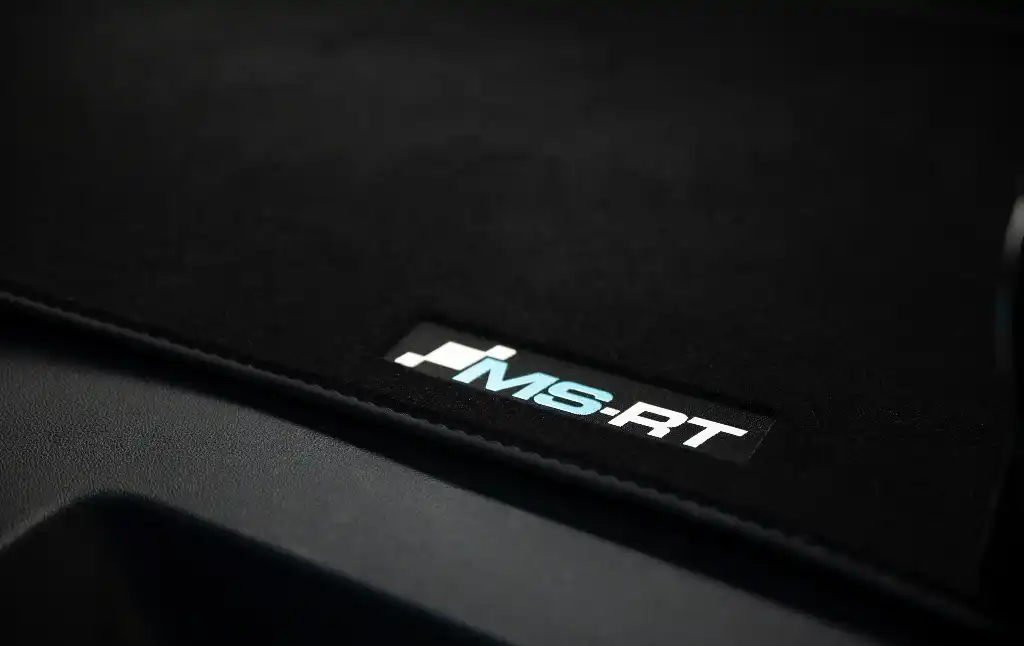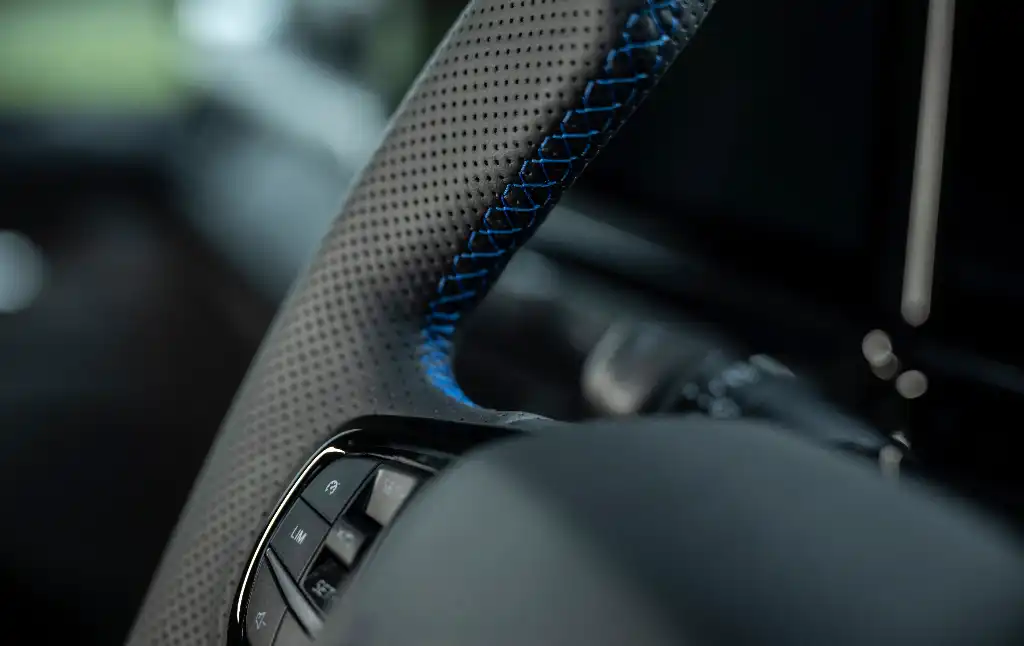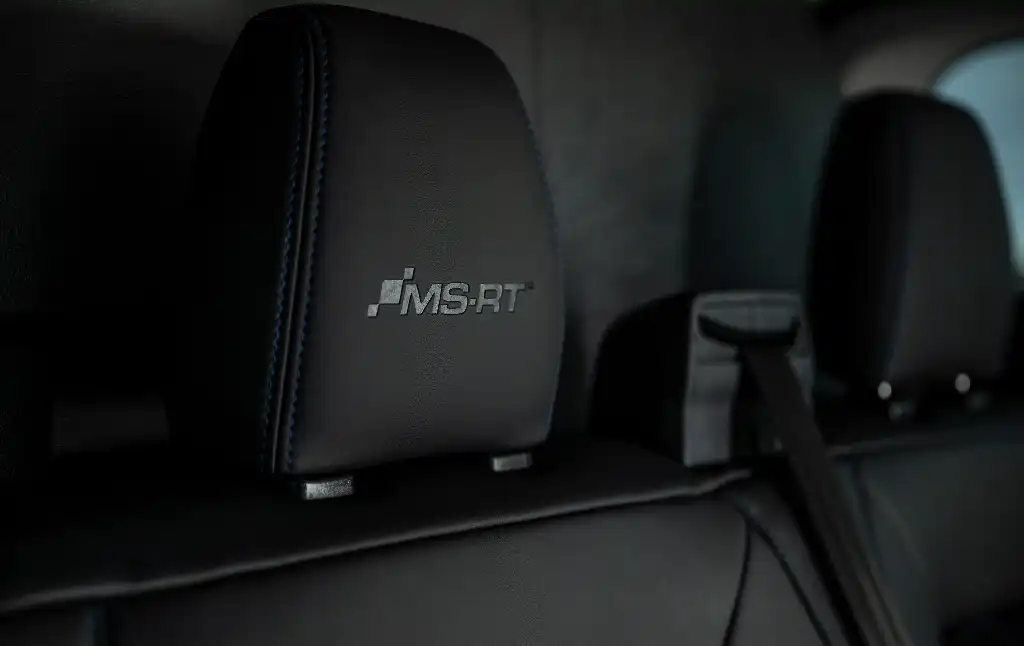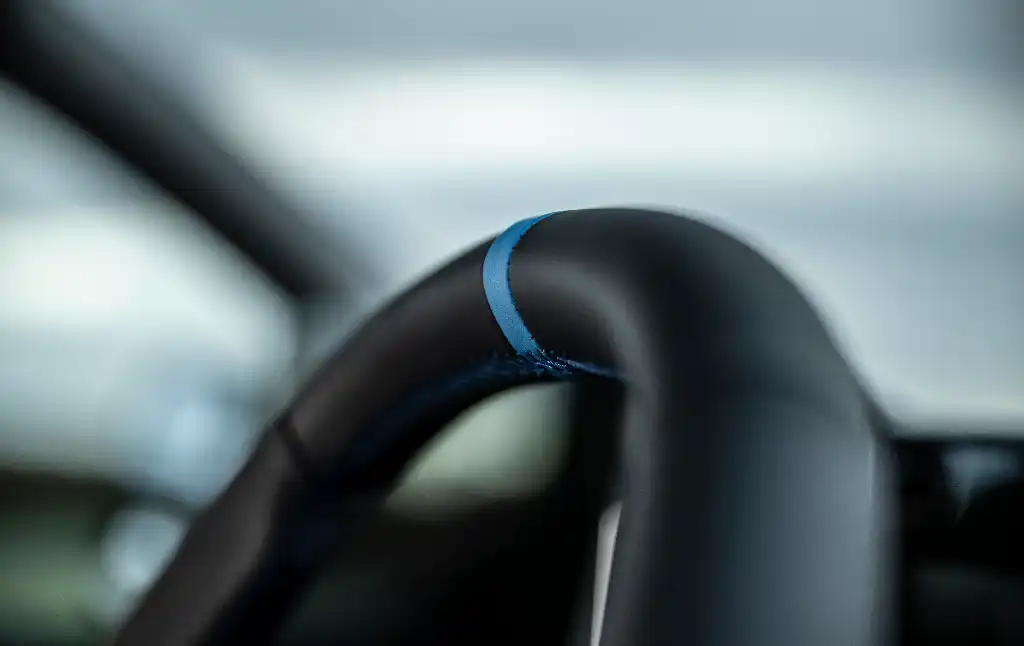Home »
Ford is at it again as they return to the legendary Pikes Peak International Hill Climb to attempt to win in the latest Ford Performance all electric demonstrator vehicle, the Ford F-150 Lightning SuperTruck.
The team has unfinished business in the mountain after narrowly missing out on an overall victory in 2023 with the Ford SuperVan 4.2 based on the Ford E-Transit Custom.
Like last years van, this year’s SuperTruck has been developed in conjunction with STARD Advanced Research and Development.
The F-150 Lightning EV demonstrator has been designed with a triple-element front wing and distinctive multi-element rear spoiler that stands more than 6ft high. There’s also headlight ducts, hood ducts and louvers as well as front dive-planes, side diffusers and a rear diffuser.
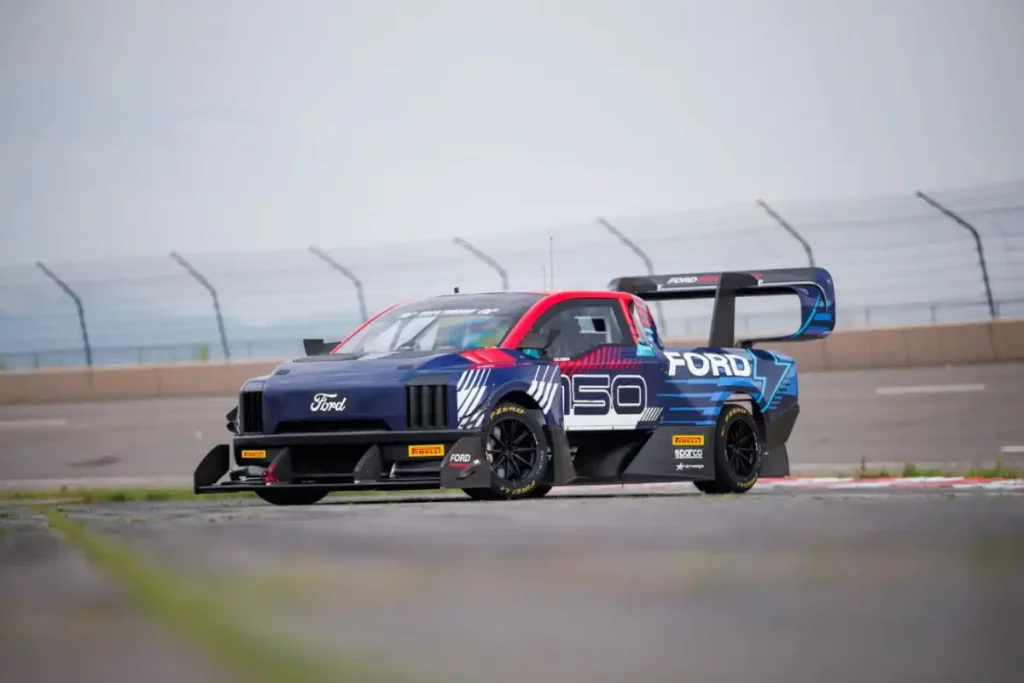
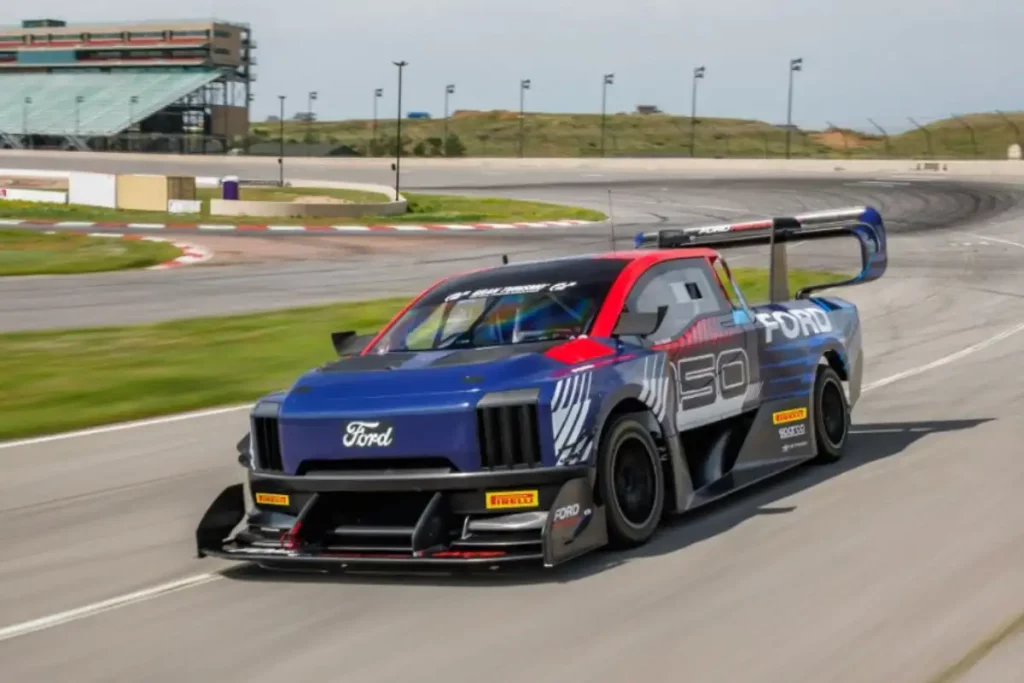
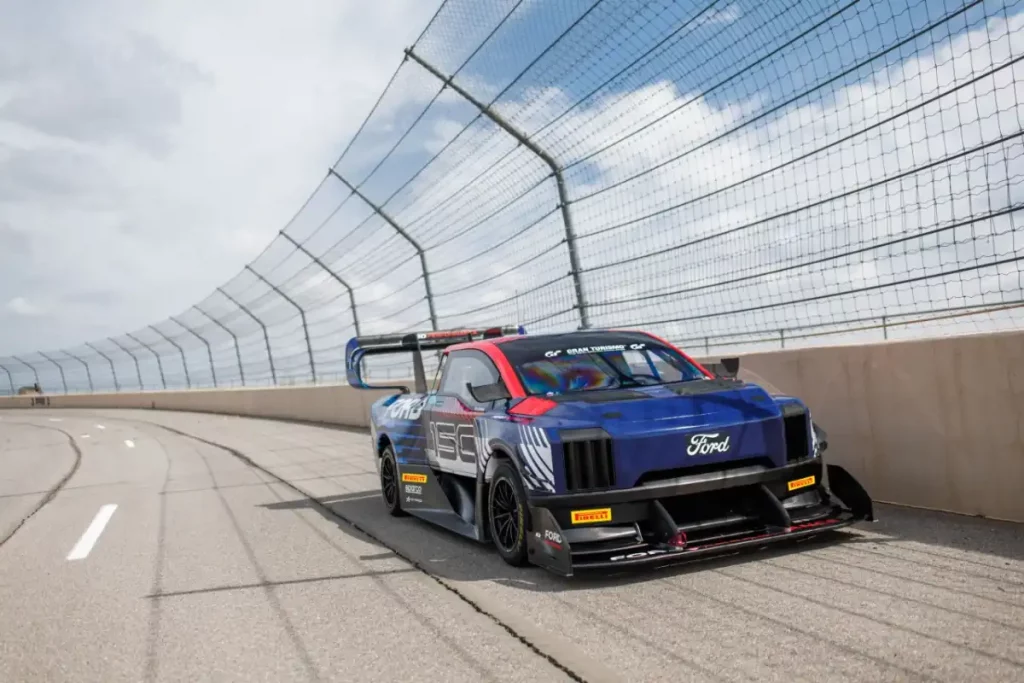
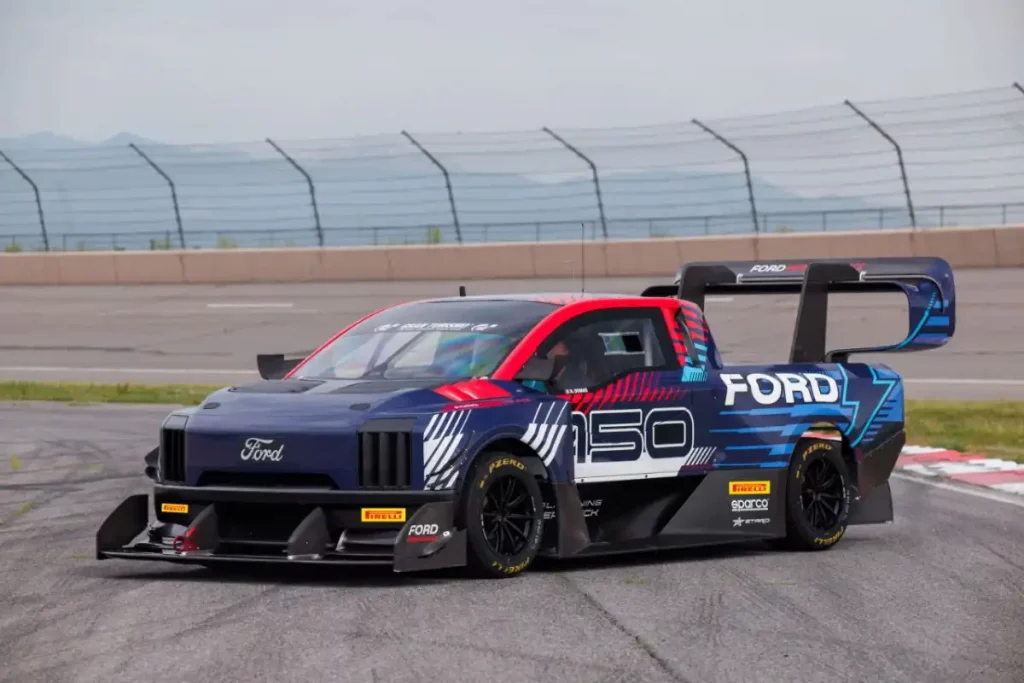
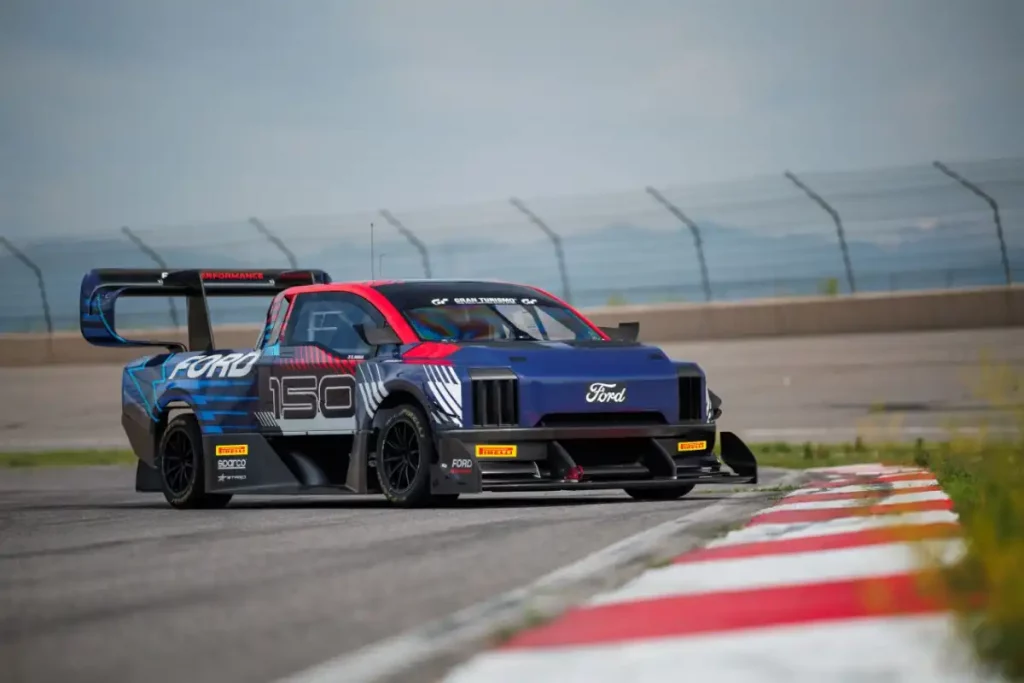
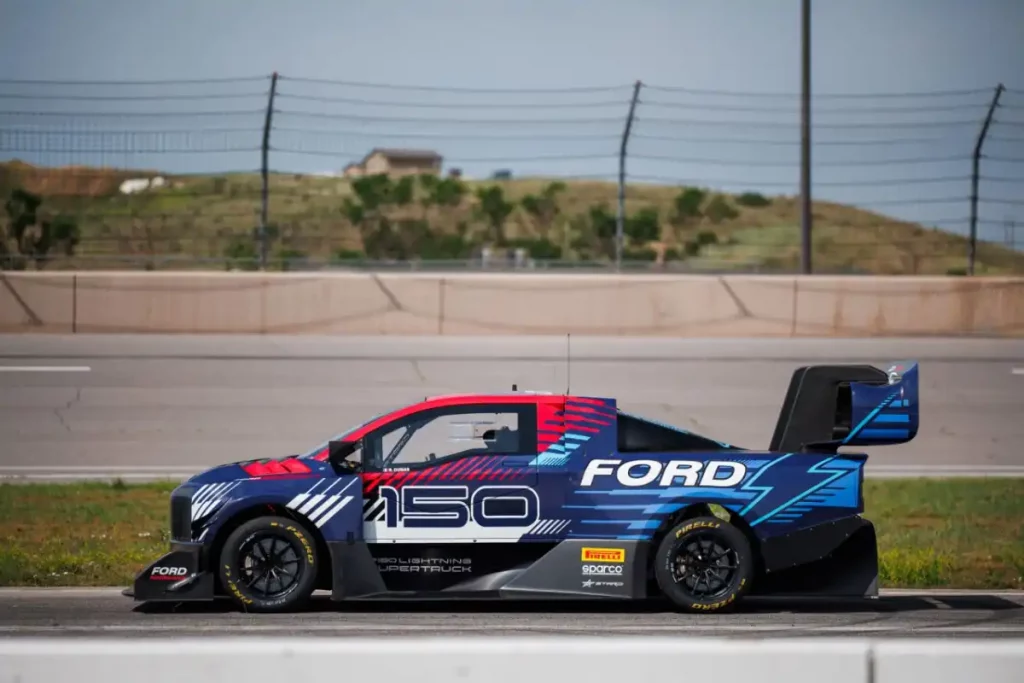
Tyre partner Pirelli has put the SuperTruck on magnesium forged wheels with Pirelli P-Zero tryes which hide a fully customised in-board suspension system.
Power is similar to the setup used on the SuperVan 4.2 with three STARD UHP 6-Phase Motors developing 1600hp. That’s a significant lift on the 1400hp produced by the SuperVan. A 50kWh battery stores enough energy to get the SuperTruck up the 14,115 ft summit and is made of ultra-high performance li-polymer NMC cells.
Driving the Pikes Peak F150 SuperTruck will be hill climb veteran Romain Dumas who also piloted SuperVan last year up the 156 corners of the infamous Pikes Peak hill climb in Colorado.
Hell-bent on capturing a win in the Open class at Pikes Peak last year, the SuperVan 4.2 managed to tackle the 12.4 miles of twisting mountain road not only to a class win at the 2023 race, but also to second in the overall competition. Ford narrowly missing out on first by just 7.6 seconds with an overall time of 8 minutes 47.6 seconds.
Dumas and SuperVan 4.2 did, however, shatter the previous Open class record of 9 minutes 24 seconds.

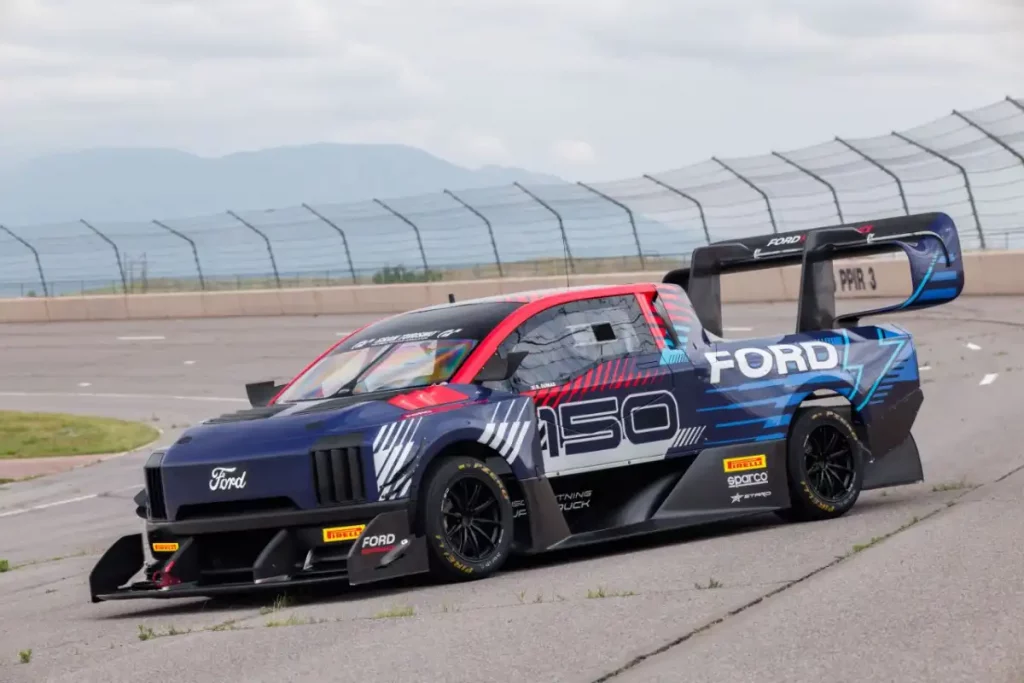

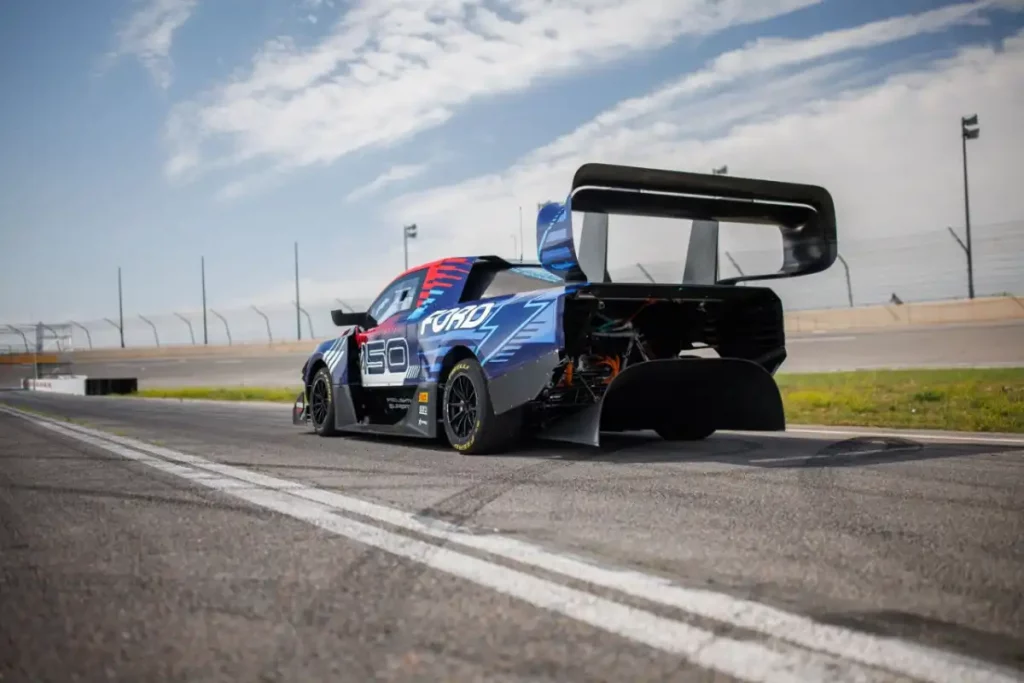
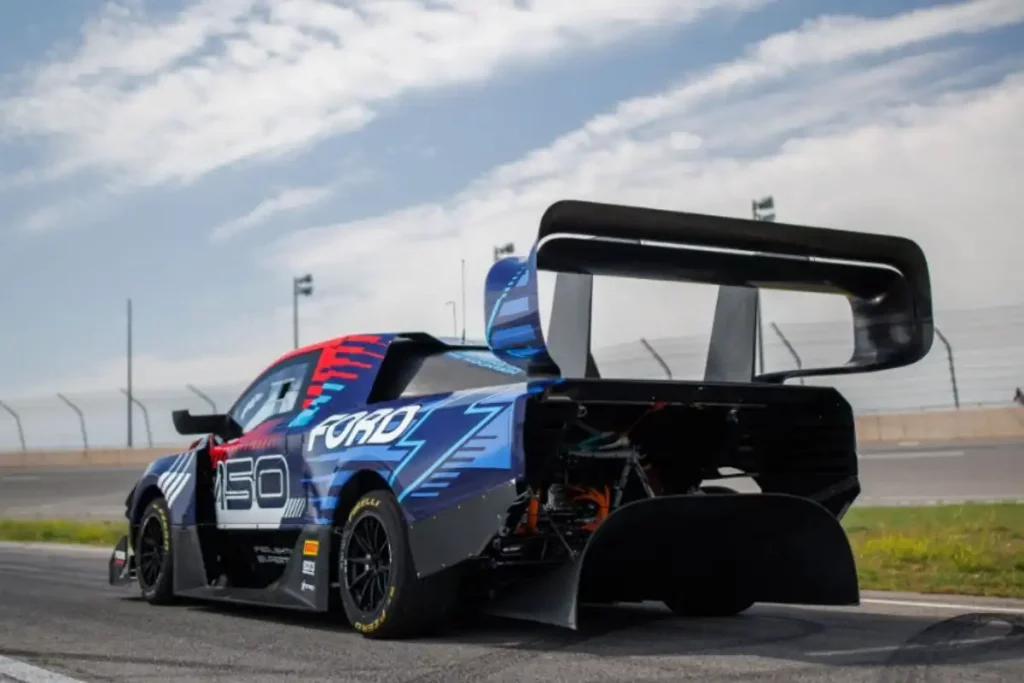
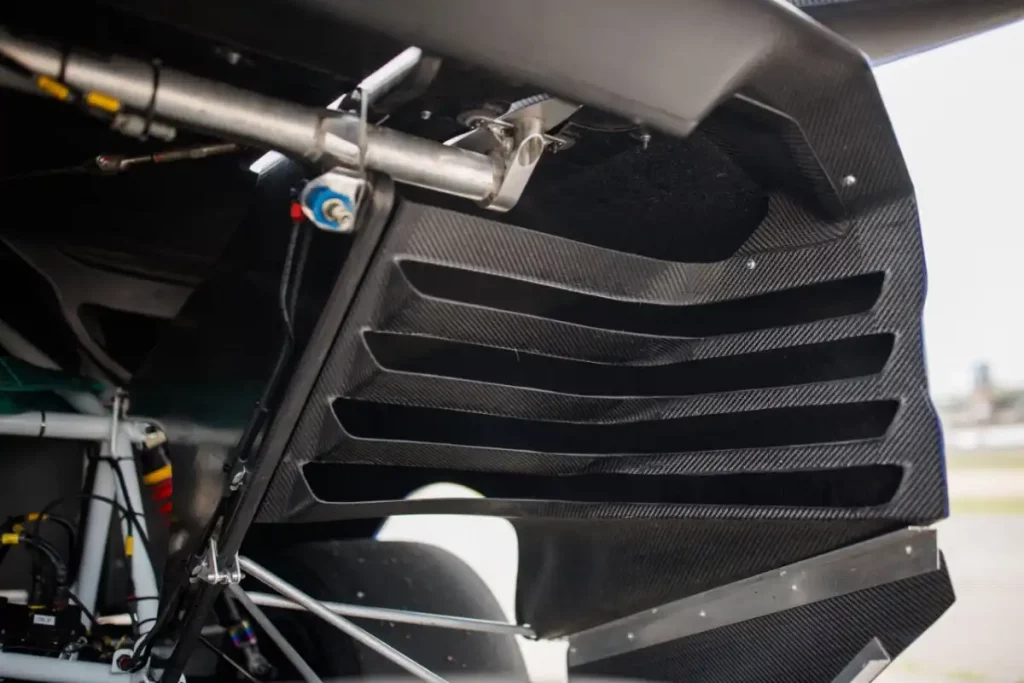
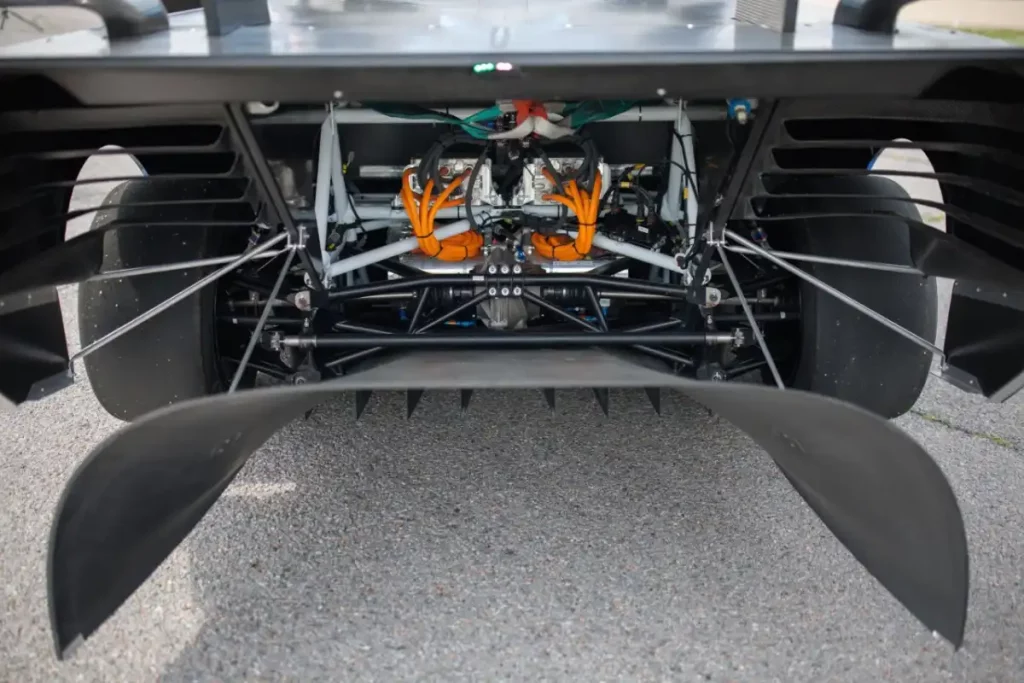
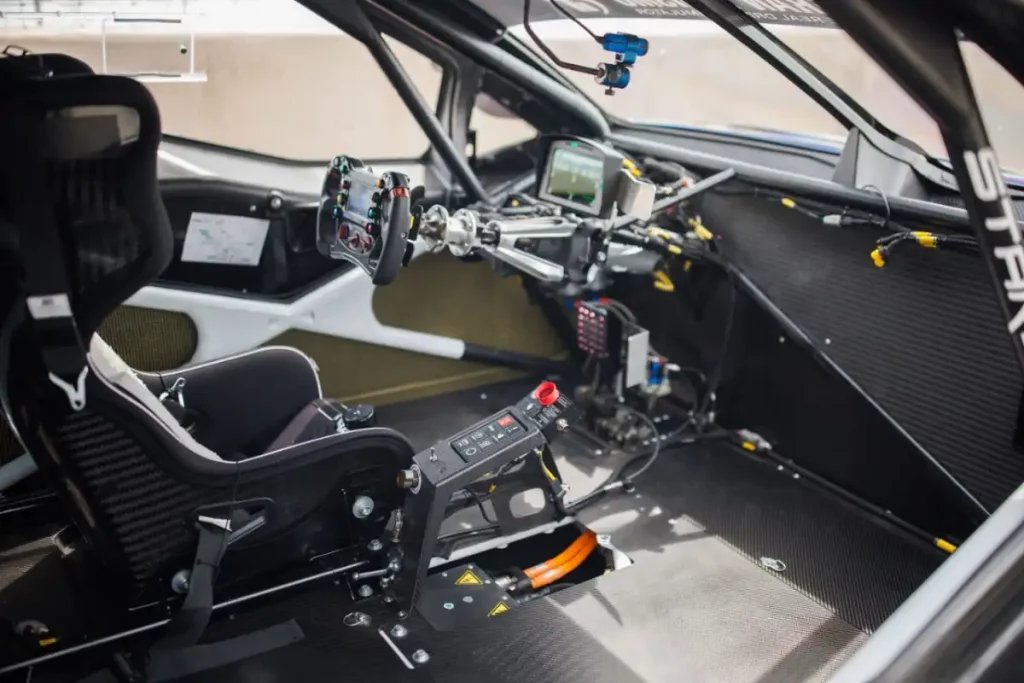
This year indicators are good that the SuperTruck will not only take the win but perhaps humble the SuperVan’s attempts from last year.
The SuperTruck managed to qualify for the race with a time of 3 minutes 32.8 seconds, 10 seconds ahead of the next fastest Wolf Aurobay GB08 in the Unlimited Class.
“After a successful 2023 climb, I’m thrilled to be behind the wheel again with this team and to help push the limits of what an electric vehicle can achieve on the turns of this legendary course,” said Dumas. “In testing, the F-150 Lightning SuperTruck has surpassed my expectations, so we are hoping for some good weather to try and do something very special.”
The Ford Transit Custom has been scored the highest level on the Euro NCAP test for medium vans with a Platinum safety rating.
The new Transit Custom scored a total of 96% receiving the highes level of "Good" in all areas tested.
In the Autonomous Emergency Braking AEB CAR-TO-CAR tests it scored a total of 27.6/30 pts, while in the AEB PEDESTRIAN category it scored 9.3/10. For the AEB CYCLIST tests the Custom scored 9.2/10.
But it was the other three areas of the test, Lane Support, Speed Assistance and Occuptant Status Monitoring where the Transit Custom really excelled scoring full marks of 20/20 for Lane Support and 15/15 for both the Speed Assistance and Occupant Status Monitoring tests.
Euro NCAP's report on the Platinum safety score for the Ford Transit Custom said:
The Transit Custom, Ford’s mid-size van first introduced in 2012, is tested here in second-generation form, available since 2023. It is equipped with a broad range of high-performing safety equipment, much of it as standard equipment, which it shares with its passenger-carrying stablemate, the Tourneo Custom. And it excels, scoring full or nearly full points in all of Euro NCAP’s tests, and emerges with a thoroughly well-deserved Platinum grading.
A more detailed report went on to praise the Autonomous Emergency Braking systems, explaining the technology behind the safety systems that include digital mapping to identify local speed limits.
The Ford Transit Custom joins the Ford Transit Courier as Ford's second Platinum scoring van in the Euro NCAP tests.
Euro NCAP's full comments for the safety assist perfomance test are below:
"The autonomous emergency braking (AEB) system uses radar-camera fusion technology to detect other vehicles and vulnerable road users such as pedestrians and cyclists. Performance is good when approaching a stationary or slower-moving car, with collisions avoided at most test speeds, albeit with slight drop-off in performance of the forward-collision warning at the highest speeds. The system performs equally well whether the target vehicle is straight in front of it or offset to one side or the other, and there is good reaction in the scenarios where a vehicle turns across the path of the approaching van. With a pedestrian target, the system performs well in all scenarios, including those done in night-time conditions. The system reacts equally well in Euro NCAP’s cyclist scenarios, again scoring almost full points."
"The lane support system includes lane departure warning, which signals to the driver when the van is drifting out of lane, and emergency lane keeping, which intervenes more aggressively in certain critical situations to prevent the van from leaving the road. The system performed well in all tests, and includes blind spot monitoring to help the driver not to pull out in front of an overtaking vehicle."
"The Transit Custom uses a camera and digital mapping to identify the local speed limit and provides the information to the driver, allowing the limiter to be set accordingly. The limiter is able to maintain the set speed to within 5 km/h. A seatbelt reminder is standard for the driver and front passenger seat, and the Transit Custom recognises steering behaviour which is characteristic of fatigued driving, alerting the driver to the need for a break."
Euro NCAP - Commercial Van Safety 2024 report, 24 April 2024
Ford has introduced a new monthly subscription for the Ford E-Transit van to help businesses with their push for electrification.
Ford Drive allows fleets to add vehicles as they need them, enabling them to test the real-world suitability of an electric van without having to buy one.
Customers can apply directly to Ford Drive for a vehicle with fast delivery available from centrally held stock. It comes with a transparent subscription price that inlcudes full service, maintenance and repair plan. Also included are all components, tyres and breakdowns, along with Ford Pro mobile servicing.
There's a minimum term of just one month, but the monthly subscription run indefinitely. If the customers need to cancel their subscription, the Ford Drive subscription notice period is just two weeks.
Subscriptions to the E-Transit are currently being offered on the Ford Drive website at a price of £1200 per month (excluding VAT). Other options include the Ford Ranger from £1050 and the Ford Transit Custom priced at £850 per month.
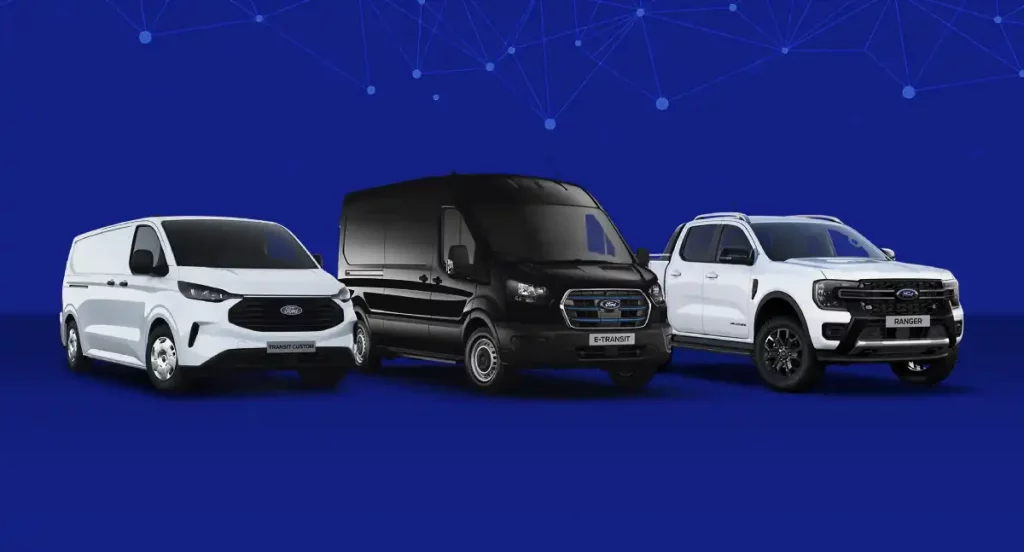
“For many businesses there are a unique mix of challenges that need to be resolved before they can be confident that an EV is a good investment for their business”, said Richard Balch, director, Ford Drive UK. “Ford Drive gives a simple way for them to effectively try before they buy. At the same point, the flexibility and services included in our subscription model also make for a compelling longer-term proposition as some customers are already finding out.”
Ford Drive is an ideal solution for businesses needing a stop-gap vehicle as well as for any business that is considering buying an electric van and wants to know if it will fit with their operation. The included services, as well as zero deposit, makes it a different option to purchasing with a very low financial commitment and limited risk.
Ford Drive was launched in mid-2023, since then, many customers have began using the subscription model as an alternative to fixed term van rental. Ford says that several of its customers also continue to roll over their subscriptions repeatedly.
Ford has expanded the range of the E-Transit with the introduction of a brand new 89kWh battery.
The new battery option will increase the Ford E-Transit's range to 402km (250 miles) on the WLTP test cycle.
Charging speeds. have also been improved with AC charge capabilities doubled from 11 kW to 22 kW, and DC fast charging increasing from 115kW to 180kW. That means that using an AC supply, a full overnight charge will take less than six hours while a DC fast charge will see 116 km of driving range added in just 10 minutes and an 10% to 80% charge taking approximately 28 minutes.
Servicing intervals are also increasing for both the new van and the current model with extended two-year/unlimited mileage service intervals - a doubling of the current one-year interval requirement.
A new vapour-injected heat pump will also be standard on the extended range E-Transit van. This will enable the cabin to be heated more efficiently and is a similar to the one used on Ford E-Transit Custom which is designed to improve energy efficiency and optimise range in colder weather.
Ford Pro expects that the increased capability of E-Transit extended range will appeal to customers with a wide range of use cases and requirements.
The new 89kWh battery will be available on E-Transit vans in L3 and L4 lengths as a van, double-cab-in-van and single chassis cab.
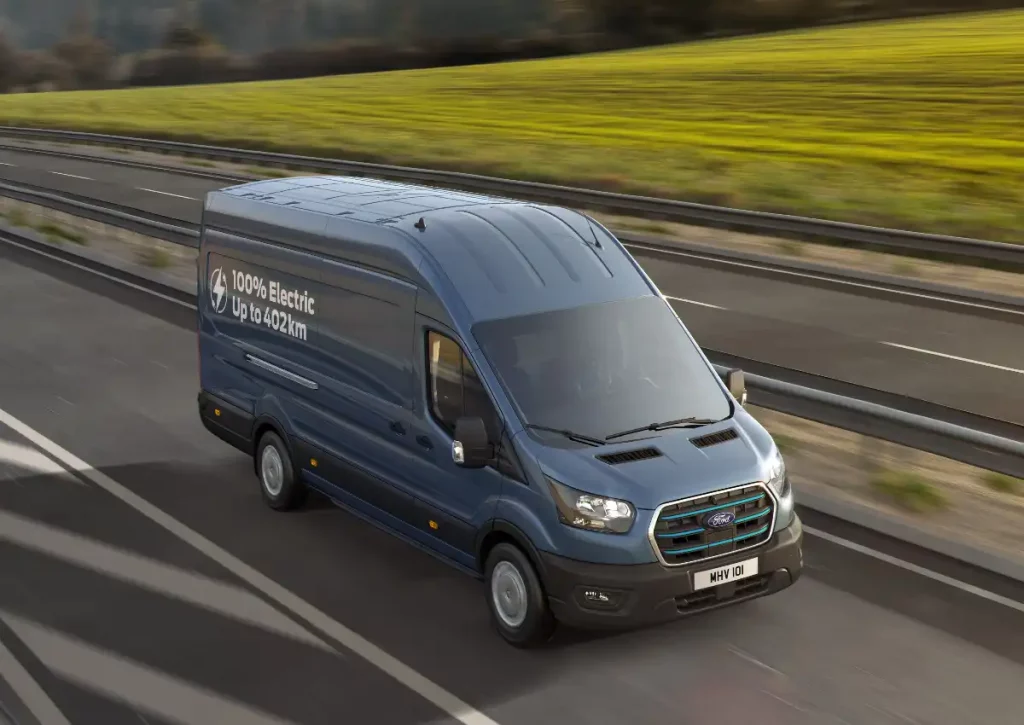
As with the existing E-Transit, GVWs will range from 3,500 kg to 4,250 kg allowing a maximum E-Transit payload of up to 1,460 kg for vans and 1,814 kg for chassis cab variants.
The extended range E-Transit will also. have a towing capacity of up to 750 kg for 3,500kg GVW vans.
“The extended range option for E-Transit is another example of the Ford Pro commitment to making high-productivity electric fleets a reality across Europe,” said Hans Schep, general manager, Ford Pro, Europe.
“Giving customers the option to drive further between charges alongside a wide choice of body styles and support from Ford Pro’s connected ecosystem strengthens our position as their trusted partner for complete fleet solutions," Schep added.
Ford Pro will also offer the E-Transit with a new factory-supported electric minibus conversion from Turkish converter ISRI.
Designed for taxi firms, schools and local authorities, the new E-Transit minibus will be able to seat up to 15 people and is based on an E-Transit L3 window van. Plated at 4,250 kg GVW, it can be specified with a single or double front passenger seat, and with a nine- or 12-seat rear layout. It's also available in either a standard or high height. Air conditioning, rear cabin heating and a powered side step are all standard. on the new E-Transit Minibus.
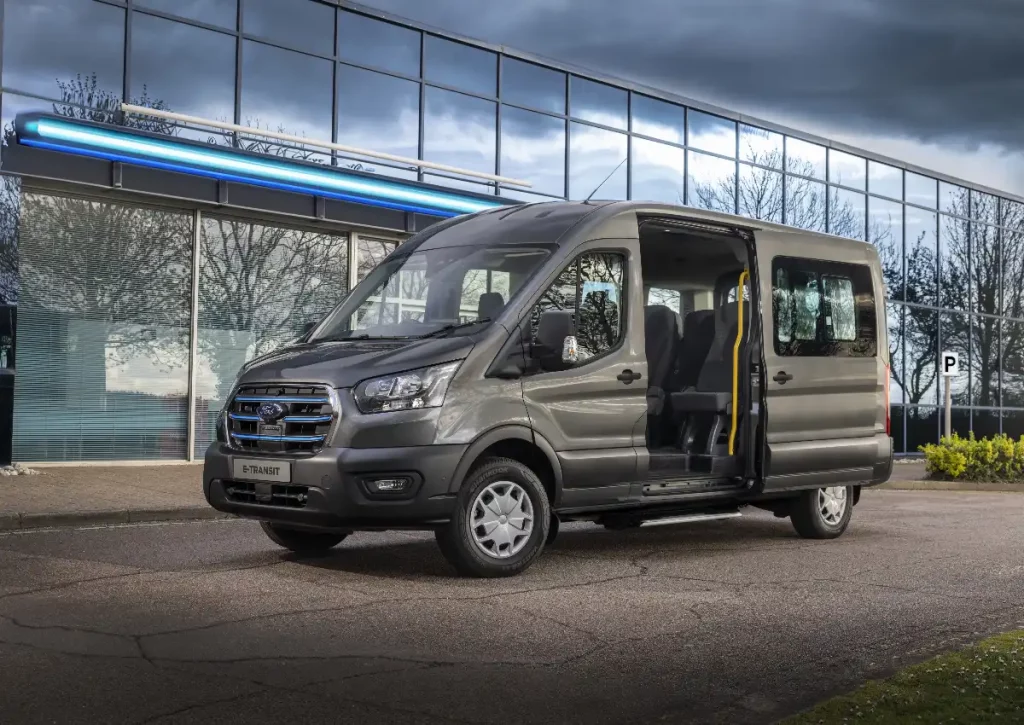
Production of commercial vehicles in the UK declined by 2.9% in the first half of the year according to the SMMT
Nissan Townstar and Nissan Primastar get Gold ratings in latest EuroNCAP Commercial Van Safety ratings test
Electric van sales remain the same as 2023 figures as the overall market for LCVs increases to highes levels post-pandemic
New price lists for the Ford Transit Custom MS-RT reveal that the starting price for the pimped up van will begin at £49,550 excluding VAT.
The entry-level MS-RT Transit Custom is the 2-litre Ecoblue 150PS model with a 6-speed manual gearbox in L1H1 size. The entry-level price for the Transit Custom MS-RT is £49,550 without VAT rising to £59,460 with the VAT and a final VAT inclusive on the road price of £61,607 inc VAT.
The new 8-speed automatic gearbox adds £2,150 to the base price, although that does include a bump in power to the 170PS version.
Plug-in hybrid PHEV models will start at £52,580 ex VAT, using a 2.5-litre Duratec engine producing 232PS.
Also revealed is the price for the all-electric version of the E-Transit Custom MS-RT that will be Ford's most powerful van to-date. The E-Transit Custom MS-RT is priced from £60,490 for the 65kWh (usable) battery version producing a massive 210kW (282hp). The final on-the-road price takes the total to an eye-watering £74,400 - ouch!
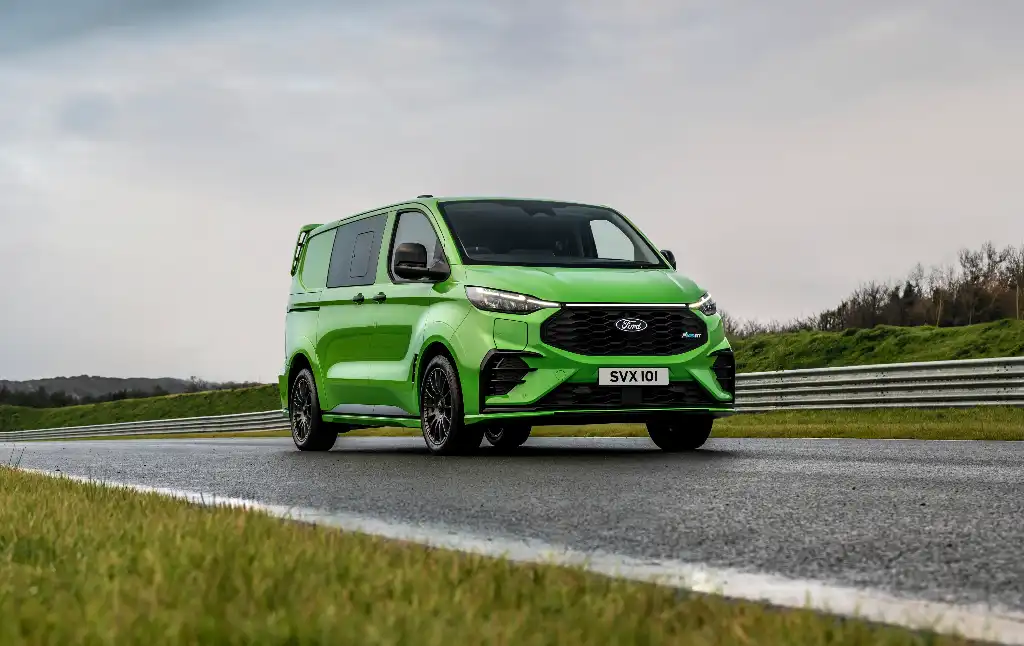
The sportiest version of the Ford Transit Custom will also be available as a long-wheelbase model with comes at an additional £700 premium for all models.
Unsurprisingly the most expensive van in the range is the long-wheelbase electric version which costs £61,190 ex VAT with an on-the-road price of £75,240 if you're paying the VAT.
In addition to the heavily revised body work that features an aerodynamic front bumper, side skirts, motorsport-inspired rear spoiler optimised for airflow and downforce, LED light strip between the headlights, wider wheelarches and special anthracite 19-inch alloy wheels, Transit Custom MS-RT models also get a unique interior.
The MS-RT Transit Custom interior gets sporty new front seats made from a non-animal Eco-Leather, along with a handful of MS-RT logos and snazzy blue stitching. To really make it stand out, it will also be available in signature MS-RT launch colours with vivid Yellow Green and MS-RT Blue.
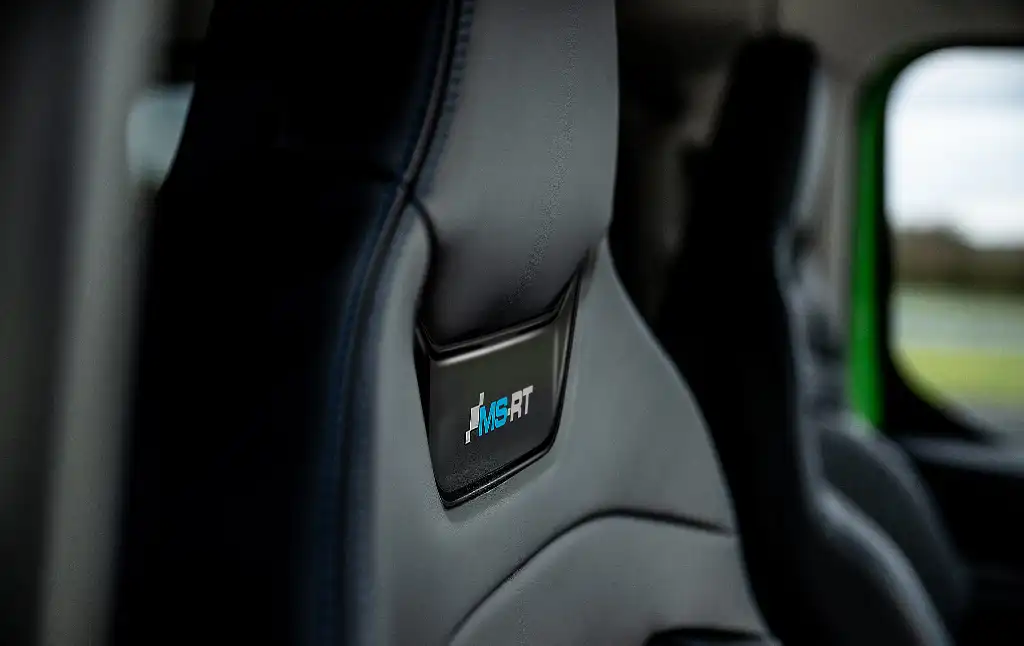

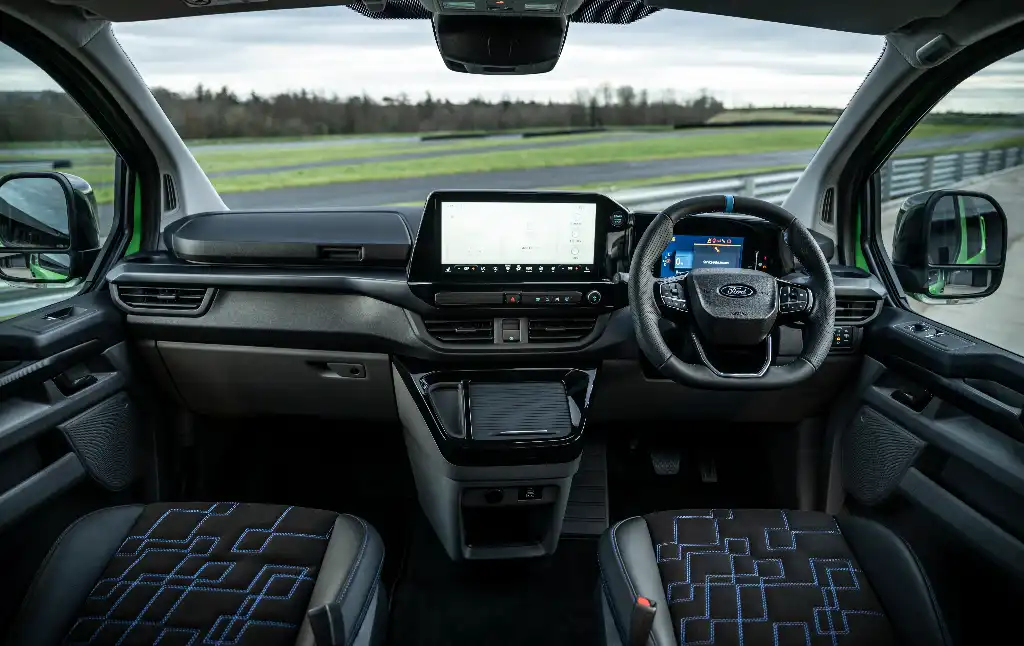
The Ford Transit Custom towing capacity is amongst the best in the medium van segment where the Transit Custom is the undeniable leader. Bought by UK van drivers in their thousands, the Transit Custom not only has a great ability to tow but is a comfortable, safe and economical van to be in.
The Ford Transit Custom towing capacity is up to 2.5-tonnes or 2,500kg. This is the total towing capacity for a Transit Custom with a braked trailer.
For an unbraked trailer is it also possible to tow up to 750kg with a Ford Transit Custom.
The Transit Custom towing capacity is what you would expect for a medium van and is an improvement over past versions which had a towing maximum of up to 2000kg. The improved 2,500kg towing capacity puts it at the top of the medium van segment along with rivals like the towing capacity of the Vauxhall Vivaro.
Each Ford Transit Custom van has the same towing capacity of 2.5-tonnes regardless of the model or engine power. Because there are 110hp, 136hp, 150hp or 170hp engines it’s important to consider that if you plan to tow a full trailer, or even a caravan, boat or car, using the Transit Custom it will be easier if you have the most powerful model.
Although simply saying that the Transit Custom can tow 2.5-tonnes makes it a nice and tidy answer, it’s not quite that simple.
Vans have a designated weight they are allowed to carry called the gross vehicle mass. This is the weight of the van (its kerb weight) plus the weight of any occupants or payloads.
There’s then the gross combination weight (GCW), also known as the gross train weight (GTW) which is the weight of the vehicle plus any load in the cargo area plus the weight of whatever you are towing.
The Ford Transit Custom towing limit is therefore the GCW which can be affected by the payload.
The Transit Custom has several permitted gross combination weights (GCW) ranging from 4,825kg to 5,725kg depending on the variants. A detailed breakdown of the GCWs is listed below which covers the engine size and gross vehicle weight (GVW) of the vans.
The GVW – which is the weight of the van plus the maximum payload – is limited to 3.2-tonnes, giving the Transit Custom a maximum GCW of 5,725kg. If you factor in the 3,225kg GVW you’ll see that 2.5-tonnes is the maximum possible towing weight for the trailer plus its payload. This means that even if fully loaded you won’t exceed the combined weights of the van plus trailer.
| Transit Custom GCW - Maximum (kg) | T280 | T300 | T320 |
|---|---|---|---|
| 2.0L TDCi Ford EcoBlue 110 PS (80 kW) | 4825 | 5025 | _ |
| 2.0L TDCi Ford EcoBlue 136 PS (100 kW) | 5325 | 5525 | 5725 |
| 2.0L TDCi Ford EcoBlue 136 PS (100 kW) 8-speed automatic | 5325 | 5525 | 5725 |
| 2.0L TDCi Ford EcoBlue 150 PS (110 kW) | _ | 5525 | 5725 |
| 2.0L TDCi Ford EcoBlue 170 PS (125 kW) 8-speed automatic | _ | 5525 | 5725 |
But you can see that if you have a Transit Custom 300 with a 110hp engine that allowance is drastically reduced. Here the 5025kg GCW and the 3025kg GVW of the Transit Custom means that there is just a 2-tonne towing capacity, if the van is fully laden.
Our advice is to consult the weight plates for the vehicle towing capacity and the Ford Transit Custom payload. These will usually be found inside the door frames – usually the passenger side – or under the bonnet.
The Transit Custom doesn't come with a tow bar as standard, but there is an option for it in the lengthy list of extras. A fixed tow bar can be specified for towing large items of up to 2.5 tonnes. The optional tow bar is designed to be fully compatible with the vehicle’s electrical system with a 13-pin connection to enable brake lights linked to the van to be shown on a trailer.
Prices for the tow bar and electrics are, at the time of writing, listed at £430 while a retractable tow bar for the Transit Custom is £550 (ex VAT).
The Ford Transit is the backbone of Britain for a reason, the Ford Transit towing capacity is unrivalled in the large van sector. The Ford Transit has the towing weight of a heavyweight boxer. It pulls no punches and the Ford Transit tow rating is as good as you'll find in the large van segment.
The Ford Transit van has a towing capacity of 3.5 tonnes or 3,500kg (7716 lbs) which is the weight a Transit can tow at its absolute maximum. This is the applicable to the all 3.5-tonne GVW models as well as some of the larger weight vans - the ones with double wheels.
The maximum Ford Transit towing weight is 3500kg for a braked trailer. The maximum unbraked trailer weight is 750kg. There are a few exceptions for smaller vehicles as to what size of braked trailer they are capable of pulling.
The Transit comes in smaller sizes with vans of a 2.9-, 3.1- and 3.3-tonnes. This poses a few problems for the overall towing capacity of the Transit because the GVW alters the gross train weight (GTW) - also known as gross combination weight (GCW) - of the van.
Ford makes it really nice and easy to figure out which van you've got. That's because you'll probably know that the large Transit vans are often referred to as Transit 350. The clue here is that the 350 part is in reference to its GVW of 3.5 tonnes.
The smaller models are therefore known as follows:
If you need to know about the Transit dimensions or the Transit payload we have handy guides which also explain these weights and sizes, but those are the basics you need to know about the Ford Transit weight for towing.
It sure can, a Transit van could tow a standard unbraked trailer as well as a proper braked trailer suitable for pulling a car.
You need to be mindful of what you put on the trailer that the Transit van is towing, but as it has such a high towing capacity of 3500kg most vehicles will be ok.
It does depend on the maximum weight of the car, boat, mobile home, jet ski or whatever else it is you fancy towing. The total payload on the trailer, plus the weight of the trailer itself, must not exceeded the Transit towing capacity. As most trailers are built to be light this shouldn't alter now much your Transit van can tow, but it's important to keep the overall total in mind for a couple of reasons.
Firstly, the weight of the trailer forms part of the towing allowance. The trailer weight is also part of the overall gross train weight (GTW) of the Transit van and trailer towing combination. Importantly includes the van, the people in the van and any other contents in the van - keep reading and you'll understand why this is a really crucial factor in the towing capacity.
The Ford Transit has a gross train weight of up to 7-tonnes or 7,000kg (15,432 lbs) for the very largest twin wheel vans. The other sub 3.5-tonne vans have a GTW of 5,000kg (11,023 lbs).
But what is GTW and why does it affect what I can tow? Well, the gross train weight is the total weight of the van plus the weight of anything you are towing, so imagine you've filled a 3.5-tonne Transit van completely full of weight but then you need to tow something.
The total of the Transit, plus fuel, plus your weight, any passengers and whatever you have in the cargo area has an overall weight of 3500kg. In order to not exceed the total allowable GTW of 5500kg you must therefore not tow anything more than 2000kg.
If you want to maximise your towing capacity and tow a full 3500kg - the maximum the Transit is safely allowed to tow, so as not to damage the chassis or towing arm - then you'll have to lower the amount of weight you are carrying.
The Ford Transit tow bar isn't a standard fit item but it can be specified as an option on all models. The tow bar for the Transit costs just £400 as an option and depending on the spec of the vehicle you have gone for (ie. which trim it is, Limited, Trend etc) it will also then come with Trailer Sway Control. This is a safety feature designed to stop the trailer from snaking around when it becomes unstable.
Despite the size of a Ford Transit it is still possible to tow it. The Ford Transit has a dedicated towing eye with the mounting point. The Transit towing eye location is in the front of the grille.
First you need to get the towing eye which can be found under the passenger seat of the Transit - it's usually bolted to the floor.
You then need to connect the towing eye to the front of the van. The location to put the towing eye on the Transit is behind a small circular cover to the side of the numberplate and next to the headlight.

You'll need to push the circle in and use a plastic device (so as not to scratch the paint) to prize the cover out. Simply insert the Transit's towing eye into the recessed hole and screw it into place. You can now insert a towing rope into the hole.
As well as using and above towing eye for the front of the vehicle there is also a towing eye loop at the rear of the Transit. It's a small loop under the rear bumper that you can see if you duck down a little bit behind the van.
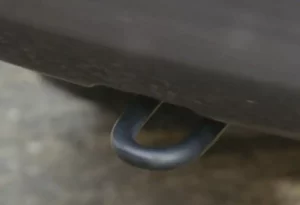
You can use it for winching the Transit van if it gets stuck so it will help with recovery. It's not to be used for towing in the same way as the dedicated towing eye mentioned above.
The Mercedes-Benz Citan and Volkswagen ID Buzz Cargo have joined the Ford Transit Courier in the highest Platinum safety rating for vans
For the first time, Euro NCAP has released crash avoidance ratings for eight vans. Each are from the small van segment, many of which have an equivalent passenger version.
The Mercedes Citan and VW ID Buzz Cargo received the highest scores, achieving a Platinum rating. The Citan scored a total of 87% acheiving the highest "Good" rating in five out of six categories - falling down on pedestrian safety where it received an "Adequate" rating.
Volkswagen's ID Buzz Cargo scored a total of 83% acheiving a Good rating in four out of six categories, and Adequate ratings for both pedestrian and cyclist safety.
Gold ratings were awarded to the Citroën Berlingo and its siblings the Fiat Doblo, Vauxhall Combo and the Peugeot Partner. Also awarded Gold was the Renault Kangoo Van - makers of the Mercedes-Benz Citan - and the Volkswagen Caddy Cargo.
Unlike Euro NCAP’s car safety rating, the commercial van rating system focuses on crash avoidance technology. This is because when a van is involved in a crash, most casualties are in the opponent vehicle or are a vulnerable road users such as a pedestrian or cyclist.
Euro NCAP introduced new safety ratings for vans in 2022, then updated their requirements when they published a new list of the safest vans in 2023.
Euro NCAP said that it noted that smaller panel vans are better equipped with safety assistance technologies than larger cargo vans. This is largely due to their relationship to passenger cars.
The safety systems Euro NCAP expects to be included in vehicles covers advanced autonomous emergency braking technologies (AEB) for car-to-car, pedestrian and cyclist, lane support systems, speed assistance, as well as attention assist.
From July, van makers will need to ensure N1 category vans have a certain standard of saftey systems fitted.
The UK's appetite for new light commercial vehicles (LCVs) continues to surge, with February witnessing a 2.2% uptick to 17,934 units, marking an impressive 14 months of consecutive growth. Today's figures from the Society of Motor Manufacturers and Traders (SMMT) reveal that this February's performance is the strongest since 1998, despite the month typically being slower due to procurement delays until March for the new numberplate.
Among the standout trends, registrations of vans weighing between 2.5 to 3.5 tonnes soared by 1.4%, representing nearly 70% of all new van sales as the preference for larger units persists. However, the small van categories witnessed declines, with small vans dropping by -20.5% and medium-sized vans seeing a -5.9% dip.
In a surprising turn, the niche 4x4 segment witnessed a remarkable 108.3% surge in registrations, while pickups, vital for rural and construction sectors, secured the third spot in commercial vehicle popularity, registering a 21.2% increase.
Fleet renewal, essential for decarbonisation, received a boost with the government's decision to scrap changes to double cab pick-up vehicle taxation, facilitating investments in newer, lower emission models. However, the sector advocates for a fairer and simpler approach to van taxation based on a vehicle's type approval.
While each manufacturer now faces mandates to achieve a minimum proportion of zero-emission registrations annually, February witnessed a slight decline in registrations of battery electric vans weighing up to 3.5 tonnes like the Ford E-Transit and Mercedes-Benz eSprinter. Maintaining incentives and expanding charging infrastructure, especially tailored for vans, will be pivotal in accelerating demand and achieving net zero targets swiftly.
In a resounding victory for Stellantis, latest figures from the SMMT reveal that almost a third of vans sold in the UK this year bear the badges of Stellantis brands. The automotive giant stands as the leading van manufacturer in 2024, with a 10% surge in volume, now boasting 32.45% of the market share year-to-date.
February saw Stellantis extend its dominance, topping the sales charts with a 7% spike, accounting for 32.91% of van sales. Vauxhall sold an impressive 4,376 units due in part to its noteworthy electric van presence.
Citroën Berlingo emerges as the nation's favorite small van, clinching both February and year-to-date top spots with 2,299 units sold. FIAT Professional also roars ahead with a remarkable 65% surge in February sales compared to last year.
Ford has revealed the first pictures and details of the eagerly anticipated Ford Transit Custom MS-RT van.
MS-RT editions of the mid-size van are something of an icon in the range owing to the motorsport inspired looks of the vehicle.
Designed as a collaboration between Ford and M-Sport, the MS-RT Transit Custom is the most eye-catching van in the line-up, sitting above the Transit Custom Sport. It will be available as both a diesel and electric version.
The fully electric Ford E-Transit Custom MS-RT can lay claim to being the highest powered Ford Transit Custom to-date. It gets a 210kW (282hp) electric motor that powers the rear wheels. It gets selectable drive modes to tone down the power when not needed with a 160kW Normal mode and 100kW when in Eco mode.
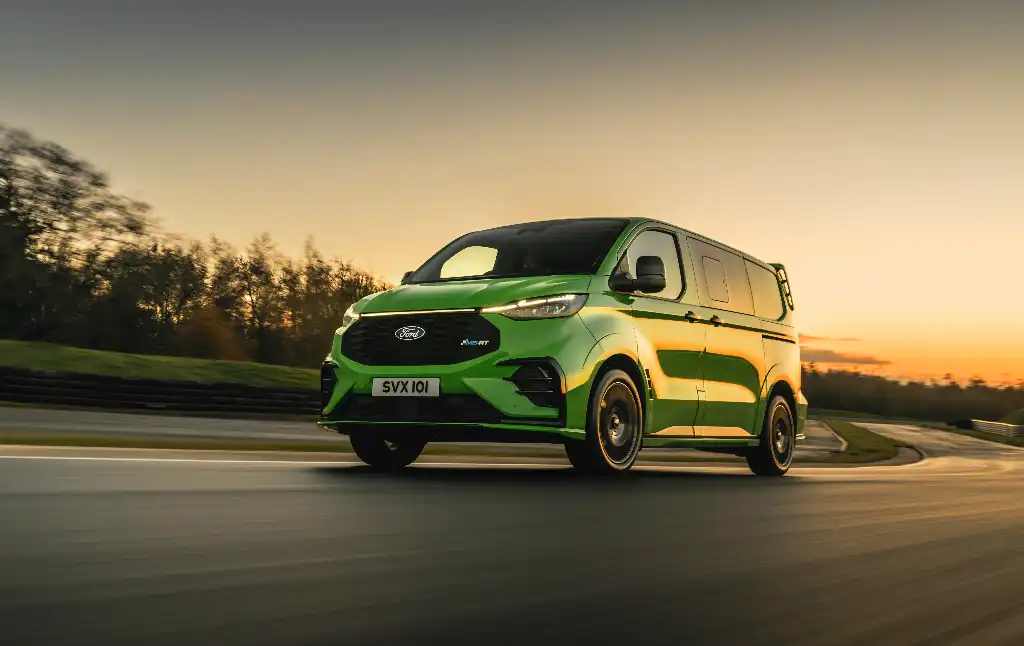
The diesel version of the MS-RT Transit Custom gets the standard 2-litre EcoBlue diesel engine. It remains unaltered from the standard van with a 168hp output and an eight-speed automatic gearbox. There’s optional all-wheel drive, or front-wheel drive. A 148hp version will also be available along with an MS-RT version of the recently revealed Transit Custom PHEV. That model has a 230hp plug-in hybrid powertrain that uses a 2.5-litre petrol engine and a 11.8kWh battery.
Of course, the Transit Custom MS-RT isn’t really about engines and power, it is about appearance. Its exterior styling is all about rally-inspired aggressiveness. It gets an aerodynamic front bumper with integrated spoiler, sports side skirts and a new sports rear quarter. This includes a bumper with integrated diffuser.

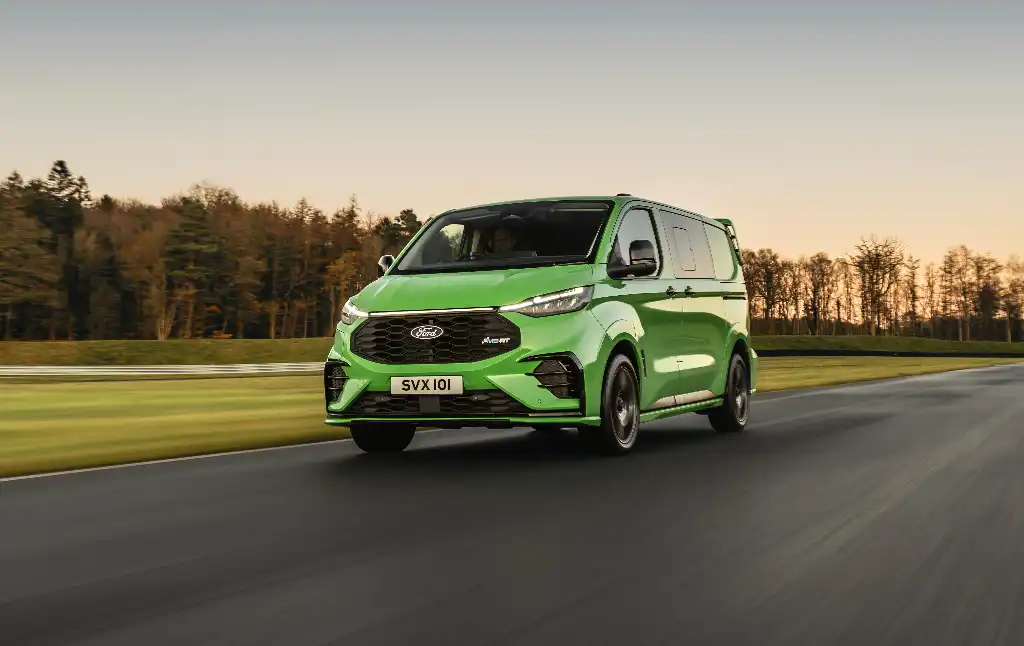
Naturally there’s a motorsport-inspired rear spoiler that has been optimised for airflow and plenty of downforce to keep the Transit Custom MS-RT and all your tools firmly stuck to the road. Electric van models will also get an additional LED light strip between the headlights.
Special anthracite 19-inch alloy wheels – which are a 0.5-inches wider than regular Transit Custom Sport wheels – sit beneath wider wheelarches. Each wheel is also more than 1kg lighter and comes with commercial-rated 235/45 R19 Goodyear Eagle Sport tyres.
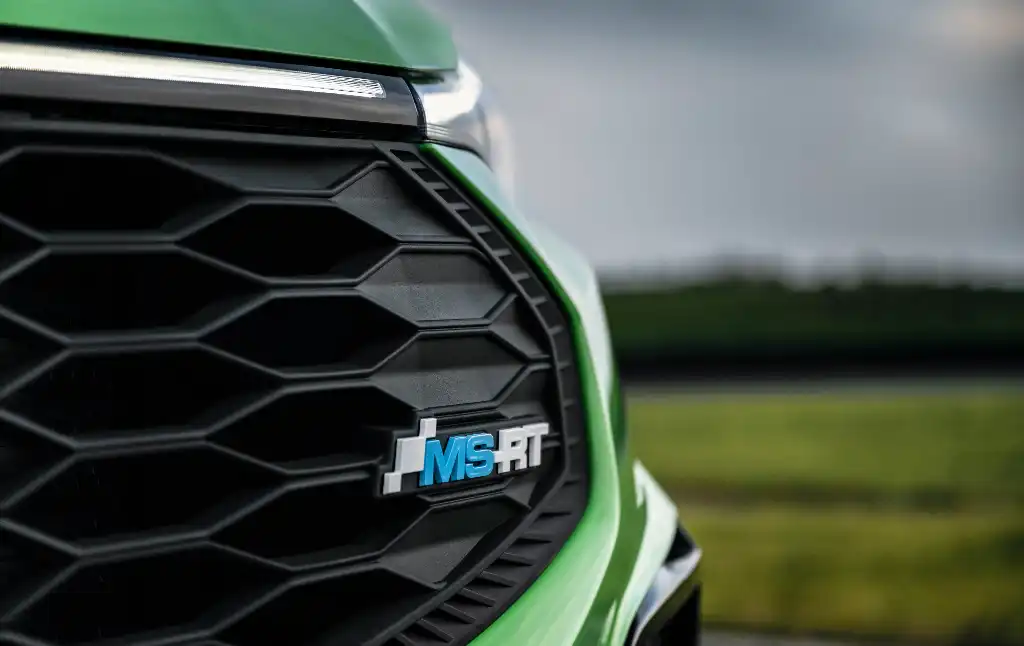
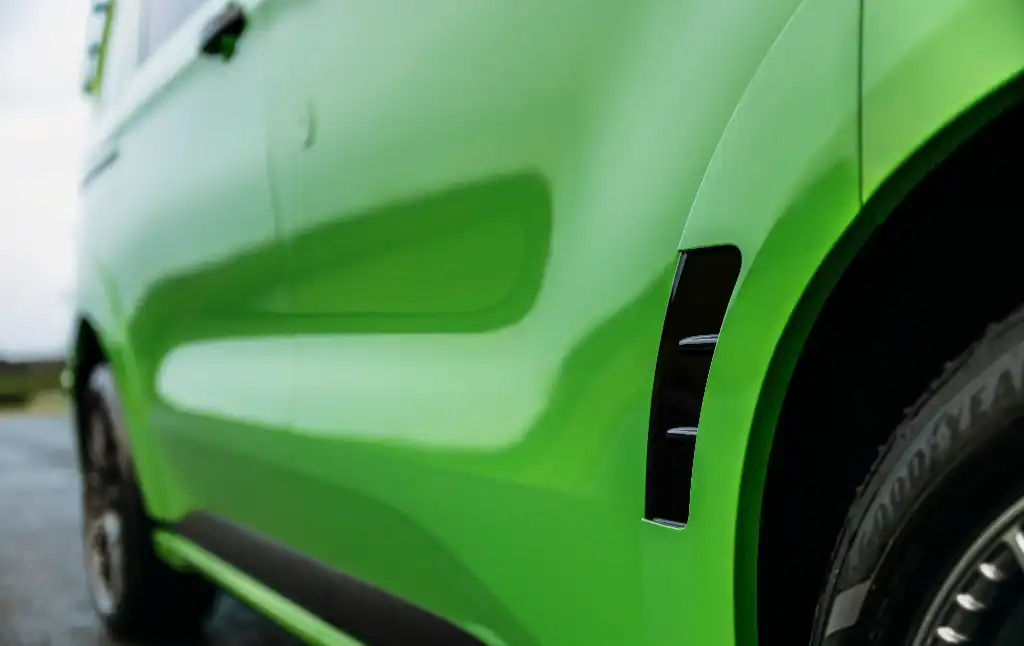
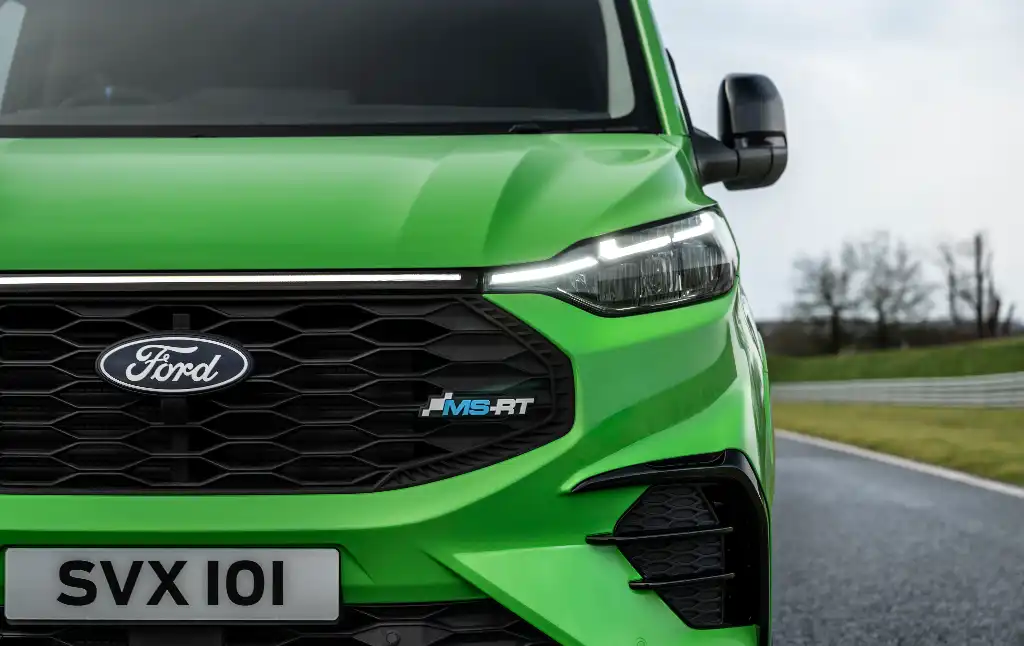
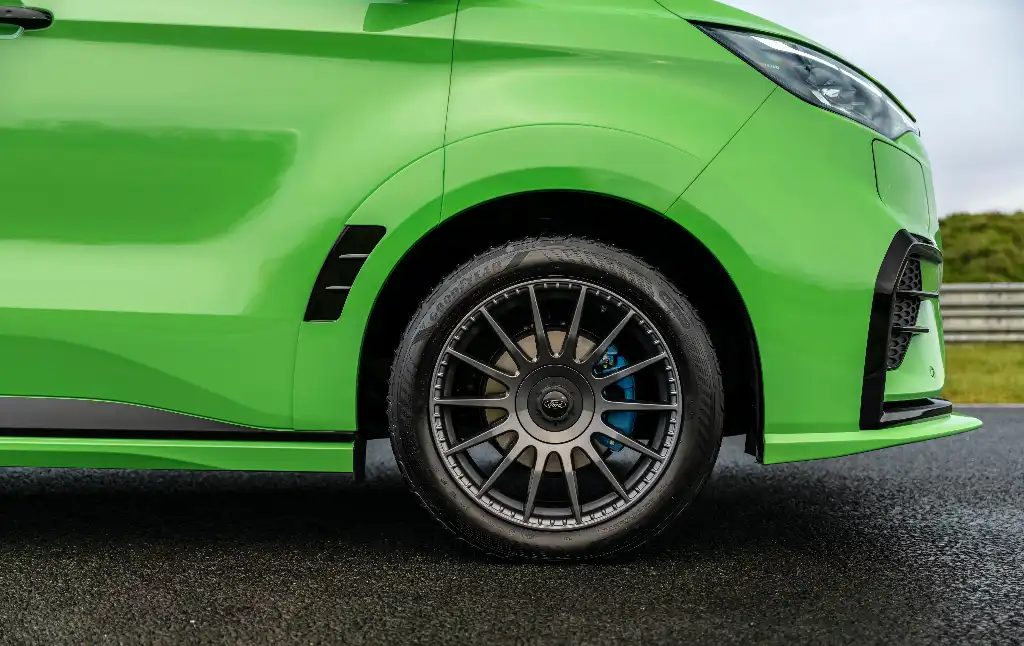
Despite all the upgrades, it’s still a proper working van and offers the full Ford Transit Custom dimensions of up to 6.8m3 maximum load space. The MS-RT Transit Custom payload is up to 1,124kg.
On the inside it gets sporty new front seats with non-animal Eco-Leather, suede, MS-RT logos and blue stitching. Signature MS-RT colours at launch will including vivid Yellow Green and MS-RT Blue. The van will also come with gloss black mirror caps and door handles as standard as well as MS-RT Blue painted brake callipers.
The Transit Custom MS-RT will be sold through Ford Pro dealers and undergoes final assembly and finishing at a dedicated new facility located on the Ford Dagenham Estate in the UK, right next to the HQ for Ford Pro’s engineering team.
Prices for the Ford Transit Custom MS-RT will start from £49,550 rising to more than £75,000 for the top spec electric version.
